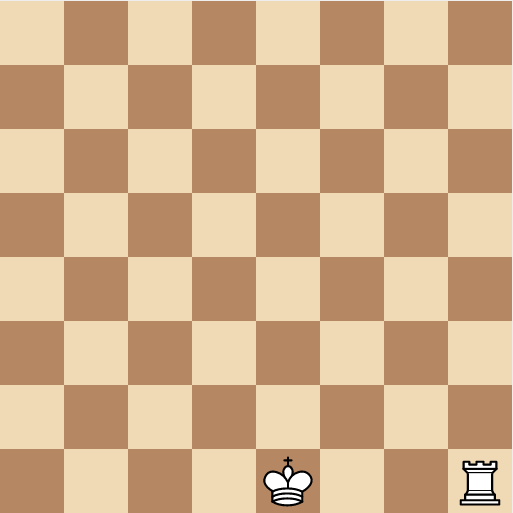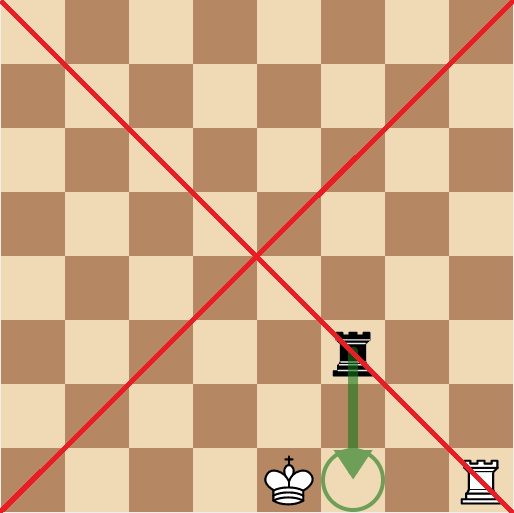|
Important rules reminder: You cannot castle when your king is in check.
|
|
|
|

|
| # ? May 3, 2024 15:50 |
|
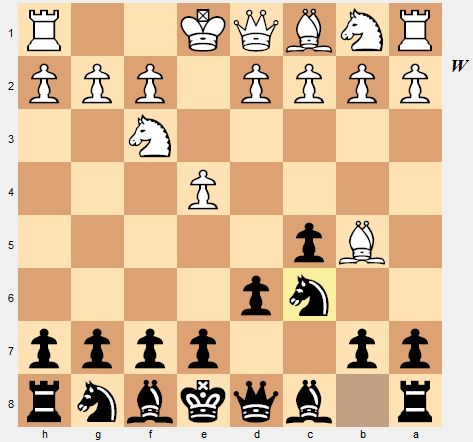 1.e4 c5 2.Nf3 d6 3.Bb5+ Nc6 White has 24 hours to decide on a move. What do you think is the opponent's best move, and what is your best counter to that move? Note that the knight on c6 is pinned to the black king and can't legally move.
|
|
|
|
I think their best move is to move Nb1-c3, because it contests the middle and protects the b5 Bishop. As for countering, start to develop the other side of the board? Maybe Ng8-f6?
|
|
|
|
From this board position, I see a few proactive plays that White can make and what I think would be our best response: 1. Nb1-c3 to protect their bishop. If they play this, we can either play e7-e5 to contest the center further (since e5 would be protected by d6), or go Bc8-d7 to further shore up the defense against the bishop (and more importantly, free up the Nc6 knight to capture e5 or d4 if needed). I like both moves equally right now, I'll think about it some more. 2. O-O to set up their rook to threaten the E column (is that the correct terminology?). In this case, I still like either of the two moves above. 3. d2-d4 to contest the middle, in which case: anakha posted:In case of d2-d4, I'm thinking we're practically forced to initiate the pawn exchange of c5xd4 because if we do anything else, they can go d4xc5 and our d6 pawn can't capture in return without exposing the Queens to each other.
|
|
|
|
idhrendur posted:
idhrendur fucked around with this message at 23:42 on Sep 18, 2017 |
|
|
|
Yeah, Nb1-c3 looks like their best move. I kinda like a7-a6 as a response, forcing them to either lose tempo or trade their bishop for our knight. During the last game came up the fact that bishops are a lot more effective as a pair, so that's an exchange I'd make. If they castle, I like Bc8-g4, pinning their knight to their queen and forcing them to lose tempo or gently caress up their pawn structure.
|
|
|
|
 One more thing! I mentioned that some of the restrictions for castling don't apply to the rook. Let me show you. One more thing! I mentioned that some of the restrictions for castling don't apply to the rook. Let me show you.If the rook is threatened, you can still castle (unlike being in check)   As well, the rook can travel through threatened spaces when castling (unlike the king) 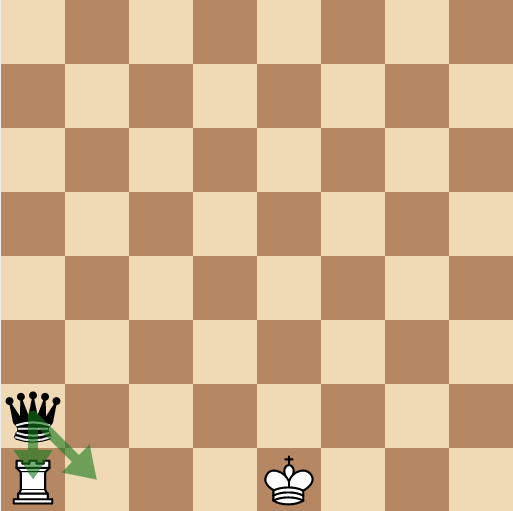 
|
|
|
|
LupusAter posted:If they castle, I like Bc8-g4, pinning their knight to their queen and forcing them to lose tempo or gently caress up their pawn structure. Flame posted:Another thing I've thought of. They can try castling next round and we basically have a free move. What if we try Bc8-g4 and pin their Knight? Then we can safely go e7-e5. Any suggestions? 
|
|
|
|
Valid objection. And sorry I didn't notice, but since these are not votes I only gave the thread a cursory read to try to form my opinion without being influenced too much. And you're right, I dicked around on lichess, trying to find a good line, and it pretty much sucks all over. I still think they will develop the knight, but if they castle we shouldn't squander the opportunity.
|
|
|
|
 1.e4 c5 2.Nf3 d6 3.Bb5+ Nc6 4.d4 You have 24 hours to decide on a move.
|
|
|
|
I kinda like the idea of doing Bc8-g4 as a means to poke a hole in the castling as well as a distracting move if they want to protect their queen, assuming they waste 2 moves doing h2-h3 and h3-g4 while we move other pieces.
Mraagvpeine fucked around with this message at 19:18 on Sep 19, 2017 |
|
|
|
So, if we take the bait and eat their pawn on d4, it starts multiple trades that go: c5-d4, Nf3-d4, Nc6-d4, Qd1-d4. So we would both lose a knight and a pawn but they move their queen to the center. I like the idea of developing our black square bishop, but would g4 really be that effective? They could just scare us off with h2-h3 same as what we could do with a6-a7 to their bishop.
|
|
|
|
If you want an alternative, we could move Qd8-a5 which would put their king in check. Whatever move they do next won't matter because our move after that is Qa5-b5 and remove that bishop. Plus those 2 moves prevent castling. EDIT: You know what, changing my vote from Bc8-g4 to Qd8-a5+. Mraagvpeine fucked around with this message at 19:40 on Sep 19, 2017 |
|
|
|
We need to be really careful about c3xd4. If they retaliate with Nf3xd4 they can take our pinned Knight, then we have to capture their Knight or it takes our Queen, their Bishop then takes the capturing pawn, and forks our King and Rook. We can force them on the defensive by going Qd8-a5+, but if they make no mistakes they'll end up with a superior position. We would exchange a Knight for a bishop, but we would have no developed pieces except for a Queen on the side of the board. I'm abstaining for now, waiting for people to post their reasoning.
|
|
|
|
I'm having trouble picturing the sequence after Qd8-a5+ that ends with that trade, can you elaborate more on that?
|
|
|
|
Frionnel posted:I'm having trouble picturing the sequence after Qd8-a5+ that ends with that trade, can you elaborate more on that? With the white king in check, they have 6 options: they could move either of their knights, queen or bishop to d2 or move their pawns to c3 or b4. Odds are they won't move their knights because that would block their queen and bishop.
|
|
|
|
Sorry, should have specified i was asking LupusAter. Specifically:quote:We can force them on the defensive by going Qd8-a5+, but if they make no mistakes they'll end up with a superior position. We would exchange a Knight for a bishop, but we would have no developed pieces except for a Queen on the side of the board.
|
|
|
|
One way I see is going Bc8-c7. We free our Knight and they have a few options. Bb5xc6: we trade our Knight for their Bishop (which is fine for me), then we trade our pawns. I think they will have a slightly better position, but in the long run, early loss of Bishop could be worse. d4xc5: practically the same happens, I guess? d4-d5: this is their best move, I think. They can choose the trade they make (either Bishop for Bishop, Knight for Knight or Bishop for Knight) but it doesn't sacrifice as many pawns as c3xd4. If someone could provide a better analysis, please do. For now, I'll leave this as my vote, though I consider c3xd4 as an alternative. I don't like moving our Queen since they can move their Knight and the pin continues.
|
|
|
|
Frionnel posted:Sorry, should have specified i was asking LupusAter. Specifically: I might be overlooking something, but if they block the check with Nb1-c3 they'll protect their bishop. We can go a7-a6 to get the bishop, they take our knight, we take it back with a pawn, then pawn exchange and it ends up looking like this. LupusAter fucked around with this message at 20:30 on Sep 19, 2017 |
|
|
|
LupusAter posted:I might be overlooking something, but if they block the check with Nb1-c3 they'll protect their bishop. We can go a7-a6 to get the bishop, they take our knight, we take it back with a pawn, then pawn exchange and it ends up looking like this. edit: On a second thought, no, I'm falling into the same trap as before. drat, this game is tough. Okay, I think moving our Queen now is viable too. Flame fucked around with this message at 20:49 on Sep 19, 2017 |
|
|
|
Oh, I didn't consider Nb1-c3. That definitely mucks up my plan. EDIT: After some thought, here's what I'm currently thinking: First we'd go Qd8-a5+; in response white goes Nb1-c3. Next we'd go Bc8-d4, threatening their knight and to an extent their queen. Wanting to protect their knights, they go Qd1-d3, which protects the knights and moves the queen into play. And then we are free to castle O-O-O which also frees our knight from protecting the king. I suppose the other side would then also castle O-O. Afterwards we take the knight Bg4xf3 which then causes them to use their queen Qd3xf3. (I suppose they could use a pawn to g2xf3, but that would expose their king.) But then we move our knight Nc6xd4 and threaten their queen. In order to prevent a check Ne4-d2+ they move the queen Qf3-e3. But instead we go Nd4xc2 and threaten their rook. This is as far as I planned ahead. Does it make sense? Did I miss anything? Mraagvpeine fucked around with this message at 21:14 on Sep 19, 2017 |
|
|
|
disregard this post
Space Kablooey fucked around with this message at 21:21 on Sep 19, 2017 |
|
|
|
Flame posted:Is it after out turn or theirs? It doesn't look as bad as I thought it would. Pinning their Knight with our Bishop seems like a good idea here. It's white's move in the board I posted. Mraagvpeine posted:Oh, I didn't consider Nb1-c3. That definitely mucks up my plan. I feel they have no reason to move their queen, their knights are already protected. On a more objective note, if the queen goes qf3-d3 instead of e3 at the end of your sequence it blocks both the check and the attack on the rook. LupusAter fucked around with this message at 21:26 on Sep 19, 2017 |
|
|
|
LupusAter posted:I might be overlooking something, but if they block the check with Nb1-c3 they'll protect their bishop. We can go a7-a6 to get the bishop, they take our knight, we take it back with a pawn, then pawn exchange and it ends up looking like this. You're completely right, i forgot about their other knight.
|
|
|
|
Mraagvpeine posted:Oh, I didn't consider Nb1-c3. That definitely mucks up my plan. In this plan, we haven't captured Bb5 and White didn't move the bishop, so Nc6 is still pinned by it. I do really like the idea of moving Qd8-a5+ to prevent the castling, but I can't think of any follow-up to the check.
|
|
|
|
HardDiskD posted:In this plan, we haven't captured Bb5 and White didn't move the bishop, so Nc6 is still pinned by it. Castling takes care of that. The main problem I have with this line is that it relies on them loving around with their queen (and making a suboptimal move at the end). Also, castling queenside leaves our king awfully exposed.
|
|
|
|
LupusAter posted:Castling takes care of that. The main problem I have with this line is that it relies on them loving around with their queen (and making a suboptimal move at the end). Also, castling queenside leaves our king awfully exposed. I knew I had to be overlooking something.
|
|
|
|
LupusAter posted:I might be overlooking something, but if they block the check with Nb1-c3 they'll protect their bishop. We can go a7-a6 to get the bishop, they take our knight, we take it back with a pawn, then pawn exchange and it ends up looking like this. This, however, doesn't look too bad for me.
|
|
|
|
LupusAter posted:I feel they have no reason to move their queen, their knights are already protected. On a more objective note, if the queen goes qf3-d3 instead of e3 at the end of your sequence it blocks both the check and the attack on the rook. I was working under the assumption that they would want to develop their queen, but I suppose they could develop their bishop instead, and Bg4xf3 would definitely cause them to move their queen. I definitely wasn't expecting my sequence to be optimal.
|
|
|
|
Mraagvpeine posted:I was working under the assumption that they would want to develop their queen, but I suppose they could develop their bishop instead, and Bg4xf3 would definitely cause them to move their queen. I definitely wasn't expecting my sequence to be optimal. I feel like it would be a little early for them to develop the queen, the board is still cramped and long range attacks are a no go. I gave a more thorough look at the position I linked before, and I kinda like where it leads us, but that's thinking 5-6 moves down the line, so nothing is certain. We seem to agree that Qd8-a5+ is the best move for now. They might miss the correct play and then it's a free bishop for us, and if they do play correctly, we can still end up taking their bishop and pinning their knight, so let's go ahead with that.
|
|
|
|
I'm also good with Edit: changed my vote to c5xd4 Ibblebibble fucked around with this message at 09:10 on Sep 20, 2017 |
|
|
|
LupusAter posted:We need to be really careful about c3xd4. If they retaliate with Nf3xd4 they can take our pinned Knight, then we have to capture their Knight or it takes our Queen, their Bishop then takes the capturing pawn, and forks our King and Rook. Hoping for White to make a mistake is what cost Black in the previous game. Just saying. I know this is a newbies' game but i really don't want to underestimate our opponents' ability to read the board and make the right moves. They seem to have played correctly so far. c5xd4 followed by Nf3xd4 and the threat to our knight in c6 seems to be easily countered by Bc8-d7, which protects the knight in c6 by both the bishop and a pawn. If they want to trigger the exchange of pieces after that (either Bd5xc6 or Nd4xc6), we would end up with the following board, which I'd much prefer over the potential board position Qd8-a5+ would leave us in.  Voting for c5xd4. E: Some additional thoughts to share. Even if they don't make the mistake of initiating the exchange of pieces, I still like our board position after Bc8-d7. Their proactive options after this would likely be be Nb1-c3, or O-O. That allows us to go e7-e5 and try to wrest control of the center (if they do the former) or Ng8-f6 and threaten their exposed pawn (if they do the latter). 
anakha fucked around with this message at 01:27 on Sep 20, 2017 |
|
|
|
Those are good points and that board looks better to me. c5xd4
|
|
|
|
I'm with anakha with moving the Bishop. Bc5 - d4
|
|
|
|
Do you mean the pawn? Our bishops are both in row 8 
Frionnel fucked around with this message at 05:01 on Sep 20, 2017 |
|
|
|
anakha pretty much summed up my thoughts. If my idea of moving Bishop is nothing good, I'm voting for c5xd4. This is where Sicilian was going initially anyway.
|
|
|
|
Alright then i'll vote c5xd4 too.
|
|
|
|
I could say that quoting only the first post in a discussion in order to make your point might be a little intellectually dishonest, but when you're right you're right. Changing my vote to c5xd4
|
|
|
|
LupusAter posted:I could say that quoting only the first post in a discussion in order to make your point might be a little intellectually dishonest, but when you're right you're right. Sincere apologies, I had no intention of calling out anyone in particular. The general discussion up to the time I posted was in favor of the Queen check, and the impression I was getting was that folks were hoping White would miss the Knight block. I was having a hard time putting in words what was bothering me, and it just so happened that the last part of your post captured exactly the verbiage I was looking for. I'll take care in future moves to avoid doing that again.
|
|
|
|

|
| # ? May 3, 2024 15:50 |
|
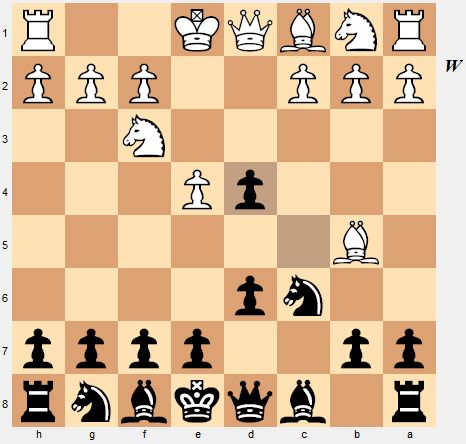 1.e4 c5 2.Nf3 d6 3.Bb5+ Nc6 4.d4 cxd4 White has 24 hours to decide on a move. What do you think is the opponent's best move, and what is your best counter to that move? Covski fucked around with this message at 21:33 on Sep 20, 2017 |
|
|









